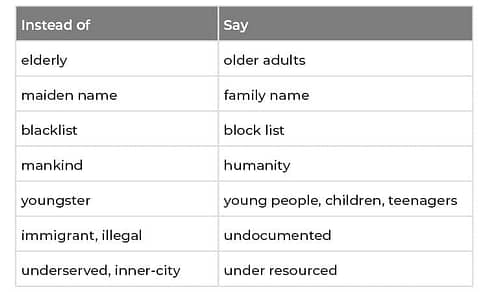Translating Inclusive Language: Tips and Best Practices
In recent years, there has been a growing recognition of inclusive language and its importance. This awareness has led to fundamental changes in the ways organizations communicate. Language expresses organizational values. By embracing inclusive language, organizations show respect for people’s identities, resulting in a culture in which all individuals feel spoken to in a meaningful way. In this article, we look at inclusive language and offer recommendations for organizations that are striving to embrace larger, less homogenous audiences with their global communications.
Why Is Inclusive Language Important in Translation?
Translation plays a crucial role in creating a more inclusive society. It promotes cross-cultural understanding and makes information, resources, and services accessible to all people, regardless of their linguistic background. Equal access is particularly important for marginalized groups who may otherwise face discrimination and exclusion due to limited English proficiency.
Language can also be a major component of organizational approaches to diversity, equity, inclusion, and accessibility (DEIA) initiatives. DEIA policies are established to foster workplace cultures that respect diversity and ensure all employees feel valued and welcome. By using inclusive language, organizations create a more respectful and accepting environment for their employees and customer base. Inclusive language also demonstrates a commitment to social responsibility and ethical business practices.
While language can be a powerful tool for promoting accessibility and inclusivity, it can also be used to perpetuate harmful biases and discrimination. The words we use, the tone we employ, and the stereotypes we reinforce through language can galvanize societal prejudices and marginalize certain individuals. This effect is exacerbated when biases are further disseminated across different languages. There are, however, decisions that can help make language inclusive and respectful to all, both in the source language and when translated.
What Is Inclusive Language?
While we might initially think of inclusive language in terms of gender, there are many other factors that contribute to inclusivity. These include age, religion, race, ethnicity, cultural identity, ability, socioeconomic status, marital status, immigration status, faith, and sexual orientation. Traditionally, language speaks to and for the people in the majority – not the minority – and as such, language can contribute to sexism, ableism, ageism, heterosexism, classism, religious bigotry, and other biases. Inclusive language seeks to recognize the minority.
Gendered language is an important part of the conversation. Certain languages – such as Spanish, French, Italian, Portuguese, and Hindi – have grammatical gender, where nouns are classified as masculine or feminine and associated words must agree. Such gendered languages typically privilege the masculine and do not include options for non-binary individuals. Many organizations that seek inclusive language embrace gender-neutral terms and/or employ other strategies for gender-inclusive translation. (Read more about Eriksen’s strategies and recommendations for gender-inclusive language in our article Gender-Inclusive Translation.)
Inclusivity in Source Content
As always, the quality of your source content will directly impact the quality of your translated content. If the source language is written in an inclusive manner, it will be easier for translators to follow suit. When creating new text, avoid potential bias and other problematic or offensive terminology, all of which will be compounded when translated into multiple languages.
Here are some best practices for writing inclusive language.
- Avoid negative terminology or terminology that implies restrictions. For example, “wheelchair bound” could be replaced with “wheelchair user.” It can be preferable to use “deaf person” or “hard of hearing” rather than “hearing impaired,” which implies a deficit.
- Describe an individual with specificity, and do not mention their identification with a group unless it is relevant to your message.
- You can rarely go wrong using person-first language, in which the individual is recognized first, not their group affiliation. For example, use “individuals living in poverty” rather than “the poor,” or “people with intellectual disabilities” instead of “the mentally retarded.”
- This is not a hard and fast rule. Identity-first language, in which the group affiliation is the focus, can be used respectfully when the group identity is treated as an expression of cultural pride or a means of reclaiming a negative term.
- Confused? The best approach is always to learn community preferences for terminology. Find out how your audience uses “Native American” vs. “American Indian” vs. “First Nation,” or “autistic” vs. “has autism” vs. “has been diagnosed with autism.”
- Understand the implications of capitalization. For example, consider terms such as deaf vs. Deaf. The former refers to a physical characteristic and the latter denotes membership in Deaf culture and community. As another example, “black” refers to color. When capitalized, the term “Black” communicates a history, identity, and community among people who identify as Black.
Here are just a few examples of ways non-inclusive terms can be replaced with other options.
As a first step to flagging problematic terminology in writing, Microsoft proofing tools include an inclusiveness setting – when enabled, it will flag many non-inclusive terms. Using this tool, you can select the conventions you want the system to flag, such as age bias, cultural bias, ethnic slurs, and more.
Let’s Chat!
Get in touch to speak with a member of our team.
Establish a Corporate Writing Guide
It’s important to be wary of unconscious bias. Also known as implicit bias, unconscious bias is an inherent or learned stereotype about an individual or group that people possess without even realizing it. For example, implicit bias can be present in an author’s writing without their awareness. A corporate writing guide is one way to counteract unintentionally biased terminology or phrasing that result from unconscious bias. An inclusive language guide provides direction for writing organizational communications in a manner that is inclusive and free of bias and stereotypes. Robust guides can be broken down into specific focus areas (gender, age, disabilities) and offer guidelines and specific terminology related to those topics.
A multilingual glossary is another tool that helps define inclusive terminology and ensure that it is used consistently in translations. Also called a terminology database or term base, a glossary lists terms and their corresponding translations. This tool allows an organization to define inclusive terminology upfront, ensuring that pre-established translations will be used correctly and consistently each time they appear in text. Because inclusive language is continually evolving, guides and glossaries must be updated regularly.
Inclusive Translation
Good translation should sound natural to the target audience. Be clear with your Language Service Provider (LSP) from the start regarding your desire for inclusive language. Your LSP will utilize linguists experienced in the use of inclusive language and ensure that glossaries and inclusive language style guides are implemented appropriately and consistently. Regarding gender-inclusive translation, there are numerous strategies translators can employ, such as changing the structure of a sentence to make it more inclusive, selecting gender-neutral terms when available, or dropping the article that marks a term as masculine or feminine.
Depending on the language and the region, certain topics will be more relevant than others. For example, in the U.S., it’s imperative to use inclusive language when talking about race, whereas in Spanish-speaking countries, the approach to gender is a larger consideration. In Arabic-speaking countries, the approach to religious terminology takes priority. As an example, in the U.S., “Black” and “Brown” are widely used. However, there is no such distinction in Spanish. When speaking about the Latino community, it is appropriate to say comunidad Latina. However, other groups are included in the term racializado, which refers to people who are not white (including indigenous people). So, “people of color” is appropriately expressed by saying personas racializadas, and “communities of color” translates as comunidades racializadas. While this approach may strike English speakers as biased, the phrases are in fact appropriate in a language that does not recognize specific terms differentiating people of color. When it comes to umbrella terms such as BIPOC, the most inclusive approach is to name each community in the way they prefer to be addressed.
Finally, when using in-house reviewers to assess translated content, make sure the reviewers are familiar with all language assets and understand the organization’s inclusivity objectives. Reviewers should recognize the implications of unconscious bias so that they know what to look for in the text they are reviewing.
A Case Study in Sensitive Terminology
Inclusive language is rapidly changing, and there is not always universal consensus on its use. A hands-on approach goes a long way. The Eriksen team had the opportunity to localize a sexual harassment prevention training module into nine languages that included sensitive terminology related to gender identity. Terms such as cisgender, transgender, and non-binary are still evolving in many languages, and there is not always agreement about their definitions. Our linguistic team first did some legwork surrounding the vocabulary, scouring websites to see how comparable organizations dealt with similar subject matter. Each of the linguists was given guidance on potentially challenging terms and their suggested usage. This thorough, investigative approach ensured that culturally sensitive vocabulary related to gender identity was used throughout the modules while communicating the tone and intent of the source material.
Featured Services
Learn more about…
Resources
The American Psychological Association has a comprehensive set of inclusive language guidelines to support the use of culturally sensitive terms and phrases that center the voices and perspectives of those who are often marginalized or stereotyped. The guide explains the origins of problematic terms and phrases and offers suitable alternatives.
The Linguistic Society of America has guidelines for inclusive language. Originally developed as guidelines for nonsexist language usage, the scope has been revised in recent years to reflect a broader focus on inclusive language, including issues related to race, disability, and other characteristics.
The National Assembly of State Arts Agencies has an inclusive language guide that provides general principles for language usage and addresses race and ethnicity, ability, age, gender and sexual orientation, as well as socioeconomic status.
The Inclusive Naming Initiative was launched by a group of tech industry organizations to facilitate the replacement of harmful and exclusionary language in information technology. The initiative aims to define processes for removing harmful and exclusionary language from IT-related material and develop resources, tools, and best practices.
Refine Your Approach to Inclusive Language
You can reach a larger audience when you are able to connect with more people in a meaningful, respectful way. However, language is always evolving, and there is no one set of formal guidelines or universally agreed-upon approach to inclusive language. Get in touch. Our team can help you develop an appropriate strategy for inclusive language that is aligned with your organizational values and culture.
 Named to the 2024 Inc. 5000 list of fastest-growing companies and ranked among the world’s top 100 language service providers by CSA Research
Named to the 2024 Inc. 5000 list of fastest-growing companies and ranked among the world’s top 100 language service providers by CSA Research


